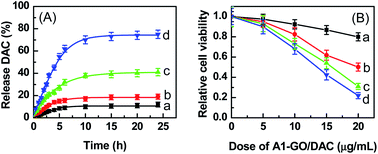Aptamer-functionalized graphene oxide for highly efficient loading and cancer cell-specific delivery of antitumor drug†
Abstract
This work reports a novel anticancer drug loading and cell-specific delivery system based on cell type-specific aptamer-functionalized graphene oxide (GO) using decitabine (DAC) and A549 cells as anticancer drug and target cell model, respectively. We conjugated GO with aptamer A1 (a 45-base oligonucleotide that binds to A549 cells with high specificity and affinity) and then loaded DAC onto the surface of GO (A1–GO/DAC complex). The loading capacity of DAC on the GO surface is dependent on pH and initial DAC concentration; the saturated loading capacity, as high as ∼3.0 mg DAC per mg GO (corresponding to the loading efficiency of ∼64%), is attained at physiological pH (7.4) and initial DAC concentration of higher than 0.7 mg mL−1. The release of DAC from the complex is also pH dependent, and DAC is released at a quicker rate at acidic pH conditions (pH 5.5) than at the physiological pH. The complexes can specifically recognize A549 cells from other types of cancer cells and subtypes of lung cancer cells due to the specific binding of the aptamer with the cells. Importantly, cell viability assay results reveal that the complex displays a much higher therapeutic efficacy in inhibiting the growth of the cancer cells by inducing cell membrane damage compared to the DAC-free drug. The high DAC payload and antitumor efficacy render our developed system promising for different biomedical applications.


 Please wait while we load your content...
Please wait while we load your content...